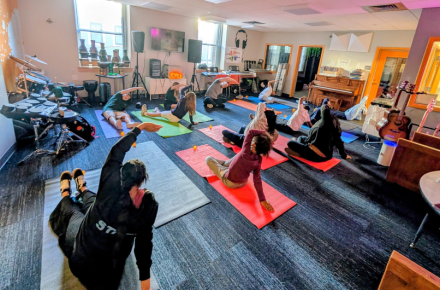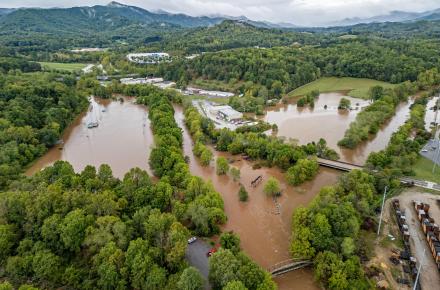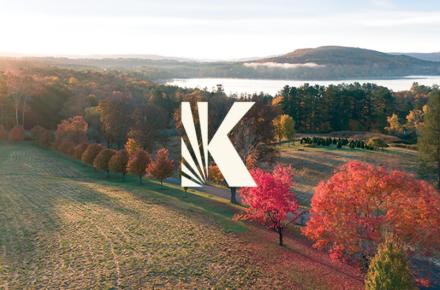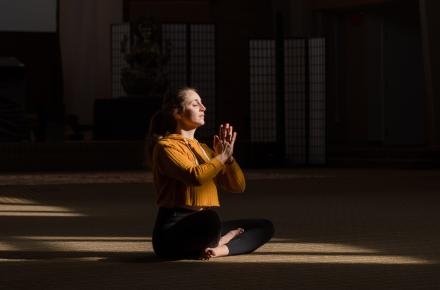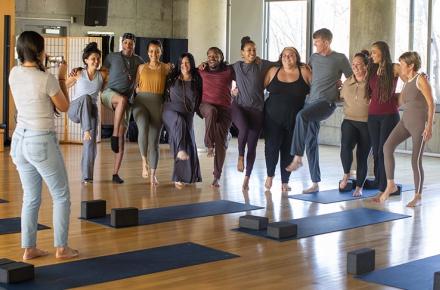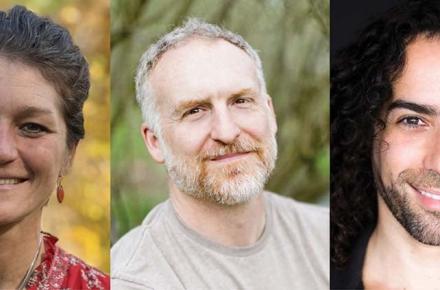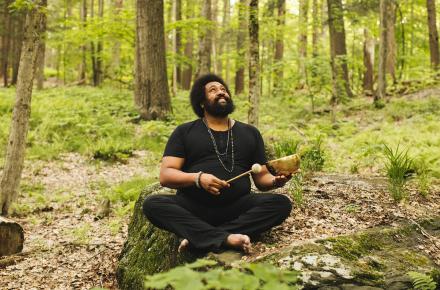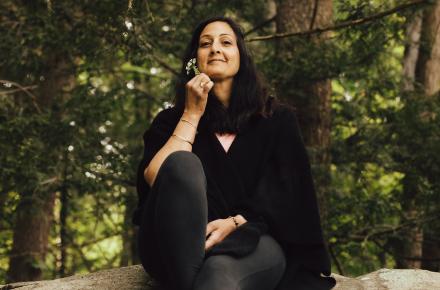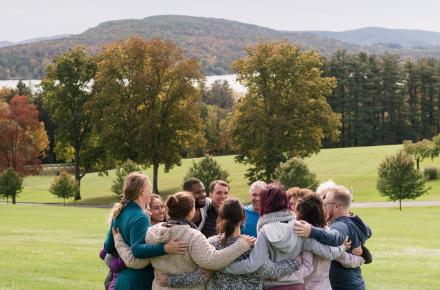What Is a Transformational Workshop?

by Ken Nelson, David Ronka, Lesli Lang, Liz Korabek-Emerson, and Jim White
At a very fundamental level, we believe transformation has to do with how we perceive ourselves in relation to our world. Transformation is a shift in our identity—who we are in relation to our work, family, friends, spirituality, sexuality, etc. Transformation is happening when we respond and react to the world differently than before. A transformational workshop is intended to facilitate, which means to “make easy” the transformational process.
In designing transformational learning experiences, we want to create the conditions for individual participants and the group as a whole to recognize change, reflect on and/or let go of the past, and enter into a “not knowing” period (what some refer to as “liminal space”) in which new possibilities can emerge. For our participants, the transformation they experience can be as simple as an insight into an obstacle that was blocking them or as grand as a fundamental shift in their perspective on who they are—in work, relationships, or community. They can shed old identities, such as the lost child, stressed-out worker, or inadequate teacher, and emerge confident that a new direction is possible, even as their initial steps in that direction feel a little shaky.
We have seen these changes—big and small—happen in hundreds of workshops. While the topic of our work is generally workshop leadership, we believe that transformation is possible with a wide variety of workshop topics and subjects because the conditions are created by the workshop design and how the content is delivered. So, whether the topic of your workshop is yoga, watercolor painting, mindfulness, or writing, we believe that you can facilitate transformation by creating the conditions by which transformation is encouraged and supported.
Our transformational workshop “theory of action” is derived from what we value. In general, what is different in a transformational workshop, retreat, or training using our theory of action is that there is an acknowledged value above and beyond the subject learned, skill acquired, or task completed. Yes, the subject is taught and content is delivered but, in the process, we also value the importance of participants, the relationships within the group, our unique experience as leaders, the individual’s experience as a source of wisdom, and the synergistic power of the group.
So how do we get there from here? Our transformational workshop model provides a blueprint, and can be stated in this way: Transformation happens in the holistic context of an intentional community, when an embodied leader uses mind-body experiences to co-create group wisdom.
Different Kinds of Workshops
We’ll illustrate the key components of our model by comparing three categories of workshops:
Conventional
Experiential
Transformational
Think back to the last workshop or training you attended. Were the chairs set up in a circle or in rows? Did you feel more like part of an audience or part of a community? Was the leader more of a lecturer or a facilitator? Did you actively participate, or did you mostly listen? Did you come away with new information, new skills, or a new perspective? These are all factors that differentiate between the three categories, which we’ll discuss below.
Transformational workshops differ from both conventional and experiential workshops in some important ways. Conventional workshops are about what you know, experiential workshops are about what you can do, and transformational workshops are about who you are and who you are becoming.
The Conventional Model
Most of us are very familiar with the conventional model. In the conventional model, objectives are mostly cognitive, knowledge-based objectives (i.e., how will each student know more as a result of the instruction?). The leader is considered to be the imparter of knowledge and usually relies on lecture or didactic instruction. Students are relatively passive, looking to the leader to tell them what they need to know.
Take a peek into a conventional classroom, and you’ll see that students sit in rows, all facing toward the front. The teacher is at the head of the class, and often relies on slides or a PowerPoint to convey information. Ninety percent of the talking is being done by the teacher, and the 10 percent of student talking is simple responses to questions posed by the teacher. Stick around for a while and you’ll see very little movement other than note-taking. In general, the conventional classroom is what we see in many schools and universities, at conferences, and in trainings where there are many students and one teacher, who is considered to be the expert.
The conventional model is appropriate for certain contexts where conveying information is important, but its ability to engage the group, unlock its creativity, and bring about lasting changes in perception and behavior is very limited.
The Experiential Model
Some of us have some familiarity with the experiential model, which has become more widely used in recent years. Ropes courses, apprenticeships, task groups, community service, and design projects follow the experiential model. In the experiential model, the leader coordinates activities that are designed to help learners acquire a specific skill or a set of skills in line with behavioral objectives (i.e., what will learners be able to do differently as a result of the learning experience?). Learners are presented with a challenge that requires them to respond differently or to interact differently with their fellow learners. In this sense, the experience does the “teaching” and the learning requires the active participation of each learner. The leader guides and coordinates and uses their expertise to help learners develop their own abilities.
Experiential learning is often used for team building. Ropes courses or other challenge-based activities are used to help a group develop communication and teamwork skills and to strengthen relationships among team members. Apprenticeship is another example of the experiential model where the master craftsman guides the apprentice through a rigorous and extended process of watching, doing, failing, fixing, and eventually mastering. The experiential model is powerful in that it actively engages learners and, in so doing, helps them transfer their newfound skills and abilities from the learning environment to the real world.
The Transformational Model
The transformational model is the model that we believe carries the most power. It incorporates aspects of the other two models, but it goes further. While there may be cognitive and behavioral objectives, transformational learning is concerned primarily with identity objectives (i.e., in what ways will each participant be different as a result of their participation?). In transformational group work, the participants come to perceive themselves, each other, and their world differently.
The transformational model relies on the premise that each person has innate wisdom, and the goal of coming together is to unlock that wisdom, both in the individual and in the group. In that sense, the transformational leader doesn’t know the exact outcome that each individual person needs, and the participants, through self-direction and self-awareness, are responsible for whatever learning takes place. In a transformational group setting, you might see participants sitting in a circle, where each person’s contributions, reflections, and insights carry equal weight. And it might be difficult at first glance to identify the leader, because the leader, in addition to teaching the content or guiding the agenda, also moves among the participants and acts as a facilitator of the group process.
The transformational model makes use of activities or experiences, similar to the experiential model, but in a transformational setting the experiences are intentionally designed to activate the whole person—mind, body, heart, and spirit—in what we call mind-body experiences. These experiences are the fundamental vehicle for learning and delivering content. Additionally, time for reflection and processing, both at the individual level and the group level, is integral to the learning process and fosters the component of group wisdom. The transformational model brings together the best of the experiential and conventional models, but it invites participants further than knowledge acquisition or changed behavior. It invites participants to be different in their careers, homes, and communities.
Creating the Conditions for Transformation
Designing and facilitating transformational learning experiences requires a lot more time and effort (and wisdom) than doing so for conventional learning experiences requires. Is it worth it? We believe it absolutely IS worth it. The world needs people who are courageous enough to pass on what they’ve been given. Transformational workshops are one way to do that, and we believe it’s a very powerful way to do it.
The conditions for transformation are optimal in a group environment where there is an intention to come together and be changed by each other. We’ve seen from our own experience how powerful these learning experiences can be. The science backs it up, as do many of the world’s ancient wisdom traditions. While it may take time and effort and wisdom, it can be done!
Excerpted with permission from Creating the Conditions for Transformation, forthcoming in 2018, by Ken Nelson, David Ronka, Lesli Lang, Liz Korabek-Emerson, and Jim White.





